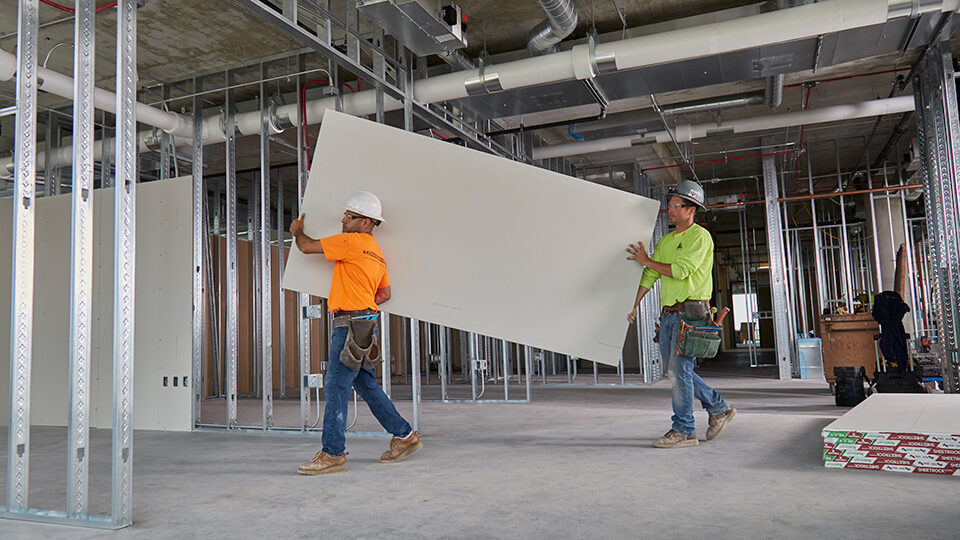
Mastering Interior Finishing: Choosing the Right Drywall and Joint Compounds for Every Project
How to Select Materials That Will Deliver Professional Results and Long-Term Performance
Interior finishing is where construction projects transform from structural frameworks into functional spaces. Exceptional interior finishing starts with selecting the right drywall and joint compounds for a project. These decisions directly affect durability, aesthetics, and overall project success.
Whether you’re working on an office building or a residential space, the materials you choose for the interior walls and ceilings determine everything from fire safety compliance to long-term maintenance costs. Smart material selection separates contractors who exceed their clients’ expectations from those who struggle with callbacks and cost overruns.
Today’s drywall manufacturers offer several options for achieving professional results while meeting increasingly stringent building codes and sustainability standards. Understanding which drywall type and joint compound combination works best for specific applications can save time, reduce costs, and improve your business reputation.
The Role of Drywall and Joint Compounds in Interior Finishing
Drywall serves as the canvas for interior spaces, providing the structural base for paint, wallpaper, and decorative finishes. Modern drywall panels have evolved far beyond basic gypsum boards, incorporating advanced technologies that address specific performance requirements like moisture resistance, fire protection, and impact durability.
Joint compounds are equally important to achieve professional finishes. They bridge the gaps between drywall panels, creating the smooth, continuous surfaces that clients expect. The right joint compound ensures proper adhesion, minimal shrinkage, and ease of sanding. These factors affect project timelines and finish quality.
Recent innovations in drywall technology have revolutionized interior finishing capabilities. Lightweight formulations reduce installation fatigue and speed up handling, while specialized panels address challenges like mold growth in humid environments or impact damage in high-traffic areas. These advancements allow contractors like you to use materials that solve specific problems rather than accepting one-size-fits-all solutions.
When buying drywall and joint compounds strategically, you’re investing in materials that improve both immediate installation efficiency and long-term performance. This approach reduces warranty issues, improves client satisfaction, and supports sustainable construction practices.
Choosing the Right Drywall for Your Project
Selecting the appropriate drywall type requires matching material properties to project requirements because each drywall category offers distinct advantages for specific applications and environments.
| Drywall Type | Best For | Key Features | Applications |
|---|---|---|---|
| Sustainable Panels | Green building projects, LEED-certified buildings | Made with recycled materials, low-VOC emissions, eco-friendly manufacturing | Office spaces seeking environmental certifications, schools with sustainability goals |
| Lightweight Drywall | Projects requiring efficient handling and installation | Up to 30% lighter than standard panels, reduces labor fatigue | High-rise buildings, large residential developments, overhead ceiling applications |
| Fire-Resistant Panels | Areas requiring enhanced fire safety compliance | Designed to slow flame spread, meets fire code requirements | Stairwells, utility rooms, commercial kitchens, healthcare facilities |
| Abuse-Resistant Panels | High-traffic areas prone to impacts | Increased durability against dents, scratches, and physical damage | Schools, hospitals, public spaces, corridors |
| Mold-Resistant Panels | Moisture-prone environments | Treated to resist mold and mildew growth, maintains integrity in humid conditions | Bathrooms, basements, commercial kitchens, pool areas |
| Regular Panels | Standard interior applications | Cost-effective, easy installation, reliable performance | General office spaces, residential bedrooms, low-risk environments |
| Liner Panels | Specialized vertical applications | High strength design for shaft walls and enclosures | Elevator shafts, stairwells, mechanical chases |
| Plaster-Base Panels | Traditional plaster finish applications | Provides strong substrate for veneer plaster systems | Luxury homes, restoration projects, custom architectural details |
Selecting the Right Joint Compound
Joint compounds impact both installation efficiency and finish quality. Understanding the specific advantages of each type helps in selecting the best materials for different project phases and environmental conditions.
| Joint Compound Type | Best For | Key Features | Applications |
|---|---|---|---|
| All-Purpose Joint Compound | Taping, finishing, and skim coating applications | Versatile, reliable performance across multiple phases, may require longer drying times in humidity | General-purpose use for most interior finishing tasks |
| Lightweight Joint Compound | Overhead work and reducing application fatigue | Easier handling, fewer heavy fillers, manageable sanding, strong adhesion | Ceilings, large-scale projects, and areas requiring reduced labor fatigue |
| Quick-Drying Joint Compound | Projects with tight deadlines | Accelerated drying time, allows multiple coats in shorter timeframes | Fast-paced projects where time is critical |
| Mold-Resistant Joint Compound | Moisture-prone areas like bathrooms and basements | Treated to resist mold and mildew growth | Bathrooms, basements, kitchens, and other humid environments |
| Mold-Resistant Panels | Moisture-prone environments | Treated to resist mold and mildew growth, maintains integrity in humid conditions | Bathrooms, basements, commercial kitchens, pool areas |
| Heavyweight/Standard Compound | High-stress joints and initial taping coats | Maximum durability and adhesion, requires more effort during sanding | Initial coats for taping and areas requiring strong bonding |
| Setting-Type (Hot/Quick-Set) Compound | Repairs and urgent applications | Powder-based, rapid setting times, exceptional durability, harder to sand | Repairs, urgent jobs, and areas requiring quick turnaround |
| Taping & Topping Compounds | Initial taping and final smoothing phases | Taping compounds bond well for initial treatment, topping compounds provide a smooth sandable finish | Specialized use for taping and finishing |
| Dust-Controlled Compounds | Occupied buildings and renovation projects | Reduces airborne particles during sanding | Renovations, occupied spaces, and areas with strict air quality requirements |
| Easy-Sand Compounds | Applications requiring extended working time and easier sanding | Balances workability with improved sanding characteristics | Projects needing flexibility and ease of sanding |
Joint Compound Selection Tips
Regional considerations may also influence joint compound selection. Humid climates may require moisture-resistant formulations, while areas with extreme temperature fluctuations benefit from compounds with enhanced flexibility.
In addition, pre-mixed formulations offer convenience for standard applications, while dry powder options allow for custom consistency adjustments based on specific project needs.
“Selecting the right joint compound is about more than just finishing walls. It provides long-term performance and client satisfaction. Contractors who understand the nuances of materials can deliver results that set them apart as professionals.”
Marty, ABC Merchandise Manager
Sustainability and Efficiency in Construction
Building material manufacturers are increasingly prioritizing environmental responsibility without sacrificing performance. Sustainable drywall options incorporate recycled content, reduce manufacturing emissions, and support green building certifications like LEED and WELL.
Eco-friendly joint compounds minimize volatile organic compounds (VOCs), improving indoor air quality and supporting healthier building environments. These formulations often exceed traditional performance standards while reducing environmental impact through sustainable sourcing and manufacturing processes.
Energy-efficient construction materials do more than just their job – they boost overall building performance. Selecting the right drywall and installing it correctly helps create thermal barriers that make HVAC systems work more efficiently, while quality finishing products can reduce maintenance and keep the building looking great for longer. It’s a win-win for saving money and reducing our environmental footprint.
Practical Applications and Real-World Examples
Successful projects require matching materials to specific applications and performance requirements. Understanding how different combinations work in real-world scenarios can help you make informed decisions and avoid costly mistakes.
Commercial Office Space
In a newly constructed downtown office building, lightweight drywall panels sped up installation, reducing worker fatigue and keeping the project on track. Fire-resistant panels were installed in mechanical rooms to meet safety codes, while quick-drying joint compounds allowed for efficient finishing without compromising quality. Additionally, soundproof drywall was used in conference rooms to increase privacy and reduce noise disruptions. The result was a modern, code-compliant workspace completed on time and within budget.
Multi-Unit Residential Building
In a multi-unit residential building, bathroom renovations demanded materials that could handle high humidity and frequent use. Mold-resistant drywall and joint compound were used to provide long-lasting protection against moisture, reducing the risk of mold growth and costly repairs. Lightweight compounds simplified overhead work in tight spaces, speeding up installation across multiple units. By selecting the best materials for the job, the contractor delivered a high-quality finish that met building codes, minimized maintenance issues, and enhanced tenant satisfaction across the property.
Conclusion
Choosing the right combination of drywall and joint compound requires balancing performance requirements, budget, and project timelines. By understanding the unique benefits of each material, you can make smart decisions that improve results and client satisfaction.
Success starts with careful planning by assessing material quality, availability, and supplier reliability. By sourcing drywall and joint compounds from reliable suppliers with robust product lines and technical support, you’ll set your projects up for success from start to finish.
Find the Right Drywall Products For Your Next Project
The information provided is for general informational purposes only. All information provided is in good faith, and is not intended as a substitute for obtaining accounting, tax, legal, or financial advice from a professional accountant or lawyer. Any opinions expressed are those of the author. L&W Supply makes no warranties of any kind, express or implied, regarding, the accuracy, adequacy, validity, reliability, availability, or completeness of any information provided herein. Any questions regarding the information provided should be addressed to the author.

L&W Supply Announces New President
Frank Marcoccio will succeed Dan Piché as president of L&W Supply, effective January 1, 2026 BELOIT, WI — October 1, 2025 — ABC Supply Co., Inc., announced Frank Marcoccio will succeed Dan Piché as president of L&W Supply, a nationwide wholesale distributor of interior building materials and construction supplies. This transition will be effective January 1, […]

Branch Location Inventory Closing Schedule – Updated
The branches listed below will be closed on the following days to complete a full inventory. Each branch will return to their regular hours the following business day. Check back as new locations may be added. 11/07/25 11/14/25 12/05/25